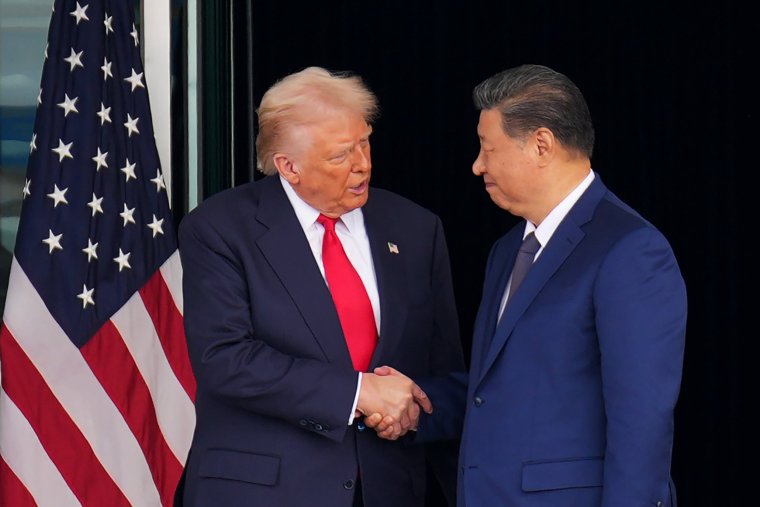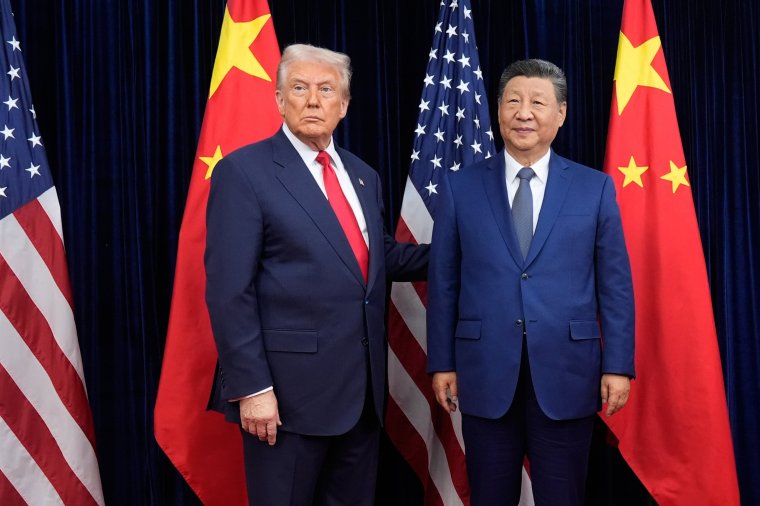It would be ‘delusional’ to conceive of the deal as an end to the ‘confrontational relationship between China and the US’, one expert tells The i Paper
Donald Trump’s trade deal with China is a temporary truce that will restore badly needed stability to the global economy for now – but confrontation between Washington and Beijing is by no means over, experts have said.
Trump hailed the deal after meeting Chinese President Xi Jinping on Thursday, claiming the agreement will bring “prosperity and security” to “millions of Americans”.
Speaking to reporters on board Air Force One after his “12 out of 10” meeting with Xi – the pair’s first since 2019 – Trump declared: “We have a deal.”
He added that “every year we’ll renegotiate the deal, but I think the deal will go on for a long time, long beyond the year”.
The agreement reeled the two countries back from the brink of a full-blown trade war, which began during Trump’s first term when the US imposed tariffs that eventually covered $360 billion worth of imports from China.
The feud culminated in April 2025, when Trump’s second administration threatened tariffs as high as 145 per cent on all Chinese goods. Beijing’s retaliatory tariffs on US imports skyrocketed to 125 percent, before both sides agreed to temporarily reduce their rates to avoid a global economic collapse.
After the pair’s “amazing” meeting, Trump said on Truth Social that Xi ordered China to begin purchasing “massive amounts” of soybeans – which it has not bought since May – as well as sorghum and other farm products.
“Our Farmers will be very happy! In fact, as I said once before during my first Administration, Farmers should immediately go out and buy more land and larger tractors,” Trump wrote.
The deal also includes a commitment to “stop the flow of fentanyl” into the US, with Beijing committing to crack down on drug’s illicit exports from China.
In response, Trump said he would reduce the minimum tariffs imposed on China – initially imposed over its illegal exports of chemicals linked to fentanyl – from 20 per cent to 10 per cent “effective immediately”.
Trump claimed the changes would reduce tariffs on Chinese goods to around 47 per cent overall.
Meanwhile, China will “begin the process of purchasing American Energy”, including “a very large scale transaction” involving Alaskan oil and gas, Trump wrote.

He added that China agreed to continue trading rare earths and critical minerals “openly and freely”, including refined lithium used in electric vehicle car batteries – a sector dominated by China.
“All of the rare earth has been settled, and that’s for the world,” Trump told reporters from Air Force One.
While acknowledging the deal could contribute to global economic stability, experts told The i Paper it amounts to little more than a “temporary truce” between the two countries, with its main benefit being the avoidance of damage caused by US tariffs.
‘Benefits and compromises’
Gordon C K Cheung, Associate Professor in International Relations of China at Durham University, said China’s resumption of soybean and sorghum imports will benefit the “US the most because the farmers producing them are the key supporters to Trump and they will be hurt the most if China won’t buy these primary products from them”.
As part of the deal, the US will suspend its Section 301 (harmful trade practices) investigations against China’s maritime, logistics, and shipbuilding industries for one year.
The measures included maritime tariffs against vessels linked to China and other foreign-built vehicle carriers.
Cheung said lifting Section 301 restrictions will be “hugely benefiting to China because China is the world’s largest ship-builder and the suspension gives some breathing time for China to re-configure or re-plan its future production.
“On rare earths and critical materials, China has been holding the Trump card, not only sources, but most importantly in refining,” Cheung added.
“China this time makes a compromise on relaxing the rare earths restriction. It gives some time for the US to find alternative countries for sourcing them as well as to better plan the building of know-how to refine them, although the US still needs a long [time] to establish the capacity.”
Meredith Crowley, Professor of Economics at the University of Cambridge, said that one noticeable exception from the trade talks was military technology.
“The US is not selling its most sophisticated memory chips to China”, despite the desire to do so from such tech giants as Nvidia, as well as China’s ambition to become a global leader in technological advancement, Crowley told The i Paper.
“The US security community, and many of the US’s security partners around the world, don’t want the most sophisticated technologies being available in China.
“The difficulty is there are security concerns with China, because it is not a democracy. So one thing that didn’t happen is the US did not say there would be a relaxation of controls on some of these technologies.”
Trump’s bid to reverse the damage
Pointing to the broader implications of the US-China deal, Crowley said: “What President Trump managed to achieve is he created a tempest in a teapot” through his far-reaching tariffs, and “now he settled things back down. It’s really a reversion to where we were before he took office,” she said.
The remarks were backed up by Xin Sun, Senior Lecturer in Chinese and East Asian Business at King’s College London, who said the deal amounted to a “temporary truce between the two countries and therefore provides the badly needed stability for the global economy, for now”.
Sun added that it would be “delusional to think of a full reversal of the increasingly confrontational relationship between China and the US as being on the horizon.
“What the deal essentially does is it prevents the further escalation of the trade war and mitigates some of the short-term disruptions – such as on rare earth supply chains for the US and on tariffs … for China – while allowing both sides to better prepare for the long-term game.”
Despite both countries making compromises – for China, buying more American soybeans and energy, and for the US, committing to reduced tariffs – these are “non-binding in nature and can be easily withdrawn”, Sun said.
“These are tactic moves rather than credible commitments,” Sun explained.
“For example, Trump can easily return to tariffs should he feel unhappy with some of China’s behaviour, as he has done multiple times in the past with other trade partners, while China can also easily walk away from any part of today’s deal without paying a huge cost.
“The deal is a compromise indeed, but a limited one that is far from being credible in the long run.”

William Hurst, Chong Hua Professor of Chinese Development, University of Cambridge, went further, saying: “Basically, nothing happened.”
Hurst said the US agreed to “roll back tariffs”, while China scrapped some “retaliatory measures or threatened measures”, but neither side “really gave anything up or gained particularly much.
He added: “This should bring some measure of greater stability, at least for now. No one knows that might happen in future rounds and this agreement is far short of any sort of comprehensive trade deal or general agreement. Rather, it is essentially a way to let Trump walk back a bit from his most reckless positions without totally losing face.”
Michael Plouffe, Associate Professor of International Political Economy at UCL, said Trump’s apparent back-tracking on his hardline approach to China could even spark backlash among his Republican base.
“The most significant point of compromise is that Trump is backtracking on his previously hardline approach to China without obtaining any meaningful gains from the previous status quo, which makes him look weak and ineffective to his supporters,” he said. “This could open him up to challenges from some of the more hawkish members of the GOP.
“The Chinese government comes out of this looking as if it has achieved more, with their countermeasures effectively bringing the US back to the negotiating table.”
Trump’s plan spans beyond China
Shifting away from the US-China deal, Crowley said the US secured deals in Asia this week that will be far more more consequential in the long run, and will leave China in a less advantageous position.
She pointed to the two trade agreements secured by the US with Malaysia and Cambodia. “President Trump has got big concessions from Malaysia and Cambodia that they are going to align their export and import policies with American security interests, with this vague caveat that they will do so as long as its their own self-interest,” she said.
“The US is deepening and strengthening its ties with these countries that China would like to have stronger and deeper relations with.”
One key commitment in those agreements cited by Crowley related to “electronic commerce, digital services, the taxation of data flows and other intangible products related to software” – an industry where the US has “huge advantages through its behemoth tech companies, like Amazon and Google”.
She said: “The US does not want other countries across the world to impose digital services taxes on digital service providers, and the US wants other rules and regulations in terms of the trans-border transmission of data. Those types of commitments – although very vaguely – are written in the Cambodia and Malaysia agreements.”
